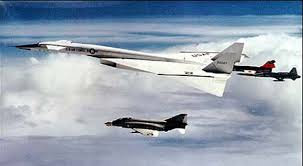 |
| North American XB-70 "Valkyrie" (Picture 1) |
Kimmo Huosionmaa
In 1960’s United States Air Force and NASA tested new supersonic bomber, what had the capacity to flight in speed Mach 3. The planes were built two individuals, and one accident has ended this program. This program was the very expensive and only one existing "Valkyrie" is located in Air Force Museum, but legend remains, that the mystery plane code-named "Dark Star" was actually "Valkyrie" what was put together by pieces what left behind from original "Valkyrie" project. "Dark Star" was CIA project for sending small satellites to low Earth orbiter after "Challenger" incident. There might be many projects, what has this name, and here I don't mean Lockheed-Martin "Dark Star" drone.
The purpose of "Dark Star" was to replace the shuttles with another kind of vehicles, because all shuttle launches were delayed because space shuttle "Challenger" was exploded in the air in 1986. And all conventional rockets were reserved for other purposes. So CIA wanted to make their own mothership for launching satellites in the low orbiter. "Valkyrie" was the very expensive project and the loss of two test pilots gave the reason for terminating this project because the know-how to build this kind of vehicle was not advanced enough in 1960's.
The accident what finally stopped "Valkyrie" project was that the XB-70 aircraft collided with F-104 “Starfighter” in the air, and causes the death of its pilots. The program was terminated because of this accident, what was the human mistake. The accident happened in 1966, but because the other aircraft were not replaced, that show that interesting about this project was die down and it was finally terminated in 1969. Technology what was made for XB-70 were used later in supersonic “Concorde” passenger plane. The part what was used was probably the geometrical solutions for wing and engine boxes.
 |
| (Picture 2) |
The thing what makes “Valkyrie” so interesting, is that this plane was very large. And it has twin tail, what makes it quite suitable for high-speed mothership missions where is tested new kind of ramjet and rocket plane technology. The twin tail lets the high-temperature exhaust gas pass the tail without damaging the tail structure. In those tests what are culminated in the X-43 test, where the mothership missions were used B-52 "Stratofortress", what launched that drone with “Pegasus” rocket.
Ultra-fast drones have one purpose, to create the flexible and small size space system, what can react very fast. In those systems, the aircraft would accelerate its speed in the atmosphere, and then it would make the hypersonic climb to space. Those shuttles are planned to operate in many missions like scientific when they would get air samples and meter the magnetic fields and lower Van Allen belt. But they are also developed for ASAT (Anti satellite) and ABM (Anti Ballistic Missile) missions. Also, they can use as the hypersonic cruise missiles and bombers with ultimate strike capacity.
The problem with miniature shuttles is that their payload is quite small. In this case, “Valkyrie” takes the miniature shuttle in the back and then the cargo-satellite would connect with it by using wire, and then the high-speed drone would accelerate it’s speed and begins the “ballistic jump”. During this jump, the drone would tow the satellite wire, what is used as a sling, when the drone turns back to Earth. “Valkyrie” offers bigger high-speed mothership capacity than other high-speed aircraft. Of course, normally air-launched rockets can be used in those missions, where extremely small satellites are launched by using airplanes. The bigger size of “Valkyrie” allows also use large test devices, what might be secret.
Sources:
https://en.wikipedia.org/wiki/North_American_XB-70_Valkyrie
https://en.wikipedia.org/wiki/NASA_X-43
https://en.wikipedia.org/wiki/Lockheed_Martin_RQ-3_DarkStar
Picture 1:
Picture 2:



No comments:
Post a Comment
Note: Only a member of this blog may post a comment.